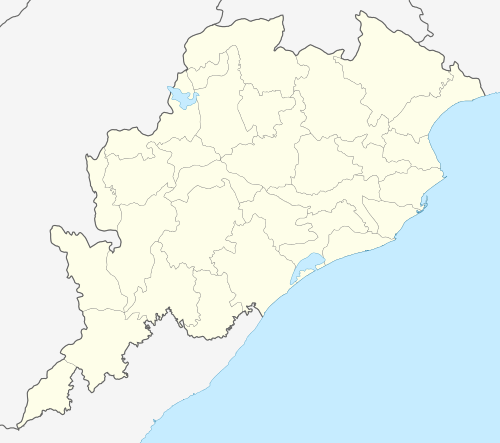Narasimha Temple
| Narasimha Temple | |
|---|---|
 Narasimha Temple Location in Orissa | |
| Geography | |
| Coordinates | 20°15′11″N 85°50′36″E / 20.25306°N 85.84333°ECoordinates: 20°15′11″N 85°50′36″E / 20.25306°N 85.84333°E |
| Country | India |
| State | Orissa |
| Locale | Bhubaneswar |
| Elevation | 20 m (66 ft) |
| Culture | |
| Primary deity | Narasimha |
| Architecture | |
| Architectural styles | Kalingan Style (Kalinga Architecture) |
| History and governance | |
| Date built | 14-15th century A.D. |
Narasimha Temple is a 14th–15th-century temple in Bhubaneswar (Lat. 20° 14’ 71" N., Long. 85° 49’ 96" E., Elev. 67 ft t) in the state of Orissa, India. The time period of its construction is estimated from its architectural features. Its tradition and legends are same as the Gosagaresvara temple. It is situated in the precinct of Gosagaresvara on the southeastern side of Gosagaresvara Siva and Paradaresvara Siva temples. The presiding deity is a four armed Narasimha image seating on a pedestal. His upper left hand holding a conch, upper right hand holds a disk while in his major left and right hand are busy in killing the demon. The base of the pedestal is carved with series of females, in anjalii mudra. The cella measures 1.15 square metres and is facing towards west.
The temple is used for worshiping.
Ownership
This temple is owned by several people. It is taken care by a private person, Nalini Kanta Panda. His residence is at Godipokhari Sahi, Old Town, Bhubaneswar. The chief priest of the temple is Mr. Mahendra Moharana.
Physical description
Surrounding
The temple surrounded by Sanisvara Siva temple in west, Paradaresvara Siva and Gosagaresvara Siva temple in the north western corner and Isanesvara in the north eastern corner.
Oientation
The temple is facing towards west.
Architectural features (plan and elevation)
The temple stands over a low pista. On plan, temple is pancharatha with a square vimana measuring 2.10 square metres and a frontal porch of 0.40 metres. On elevation, temple is in pidha order with usual bada, gandi and mastaka measuring 3.38 metres in height from bottom to top. The bada measuring 1.28 metres has threefold divisions in which pabhaga measures 0.38 metres, jangha 0.73 metres and baranda measures 0.27 metres in height. The gandi measures 1.15 metres and the mastaka 0.95 in height.
Decorative features
Doorjambs: The doorjambs measure 1.03 metres in height and 0.62 metres in width, which is a recent addition. At the lalatabimba there is a Gajalaxmi with an archaic feature.
Lintel: Plain.
Property type
The temple has the Pidha deul typology and it is a temple precinct.
Building material: Sand stone.
Construction techniques: Dry masonry
Style: Kalingan
Grade (A/B/C)
i) Architecture: C
ii) Historic: C
iii) Associational: C
iv) Social/Cultural: C
Condition of the temple
The temple was repaired by the Orissa State Archaeology under X and XI Finance Commission Award and presently maintained by the locals living around the temple. At the moment the temple is in a good state.
Detached sculptures of a four armed Ganesa and a lingam made of sand stone are there inside the sanctum.
References
- Lesser Known Monuments of Bhubaneswar by Dr. Sadasiba Pradhan (ISBN 81-7375-164-1)
- http://ignca.nic.in/asi_reports/orkhurda009.pdf
Date of Documentation
15.10.2006
Documenter
Dr. Sadasiba Pradhan and team.